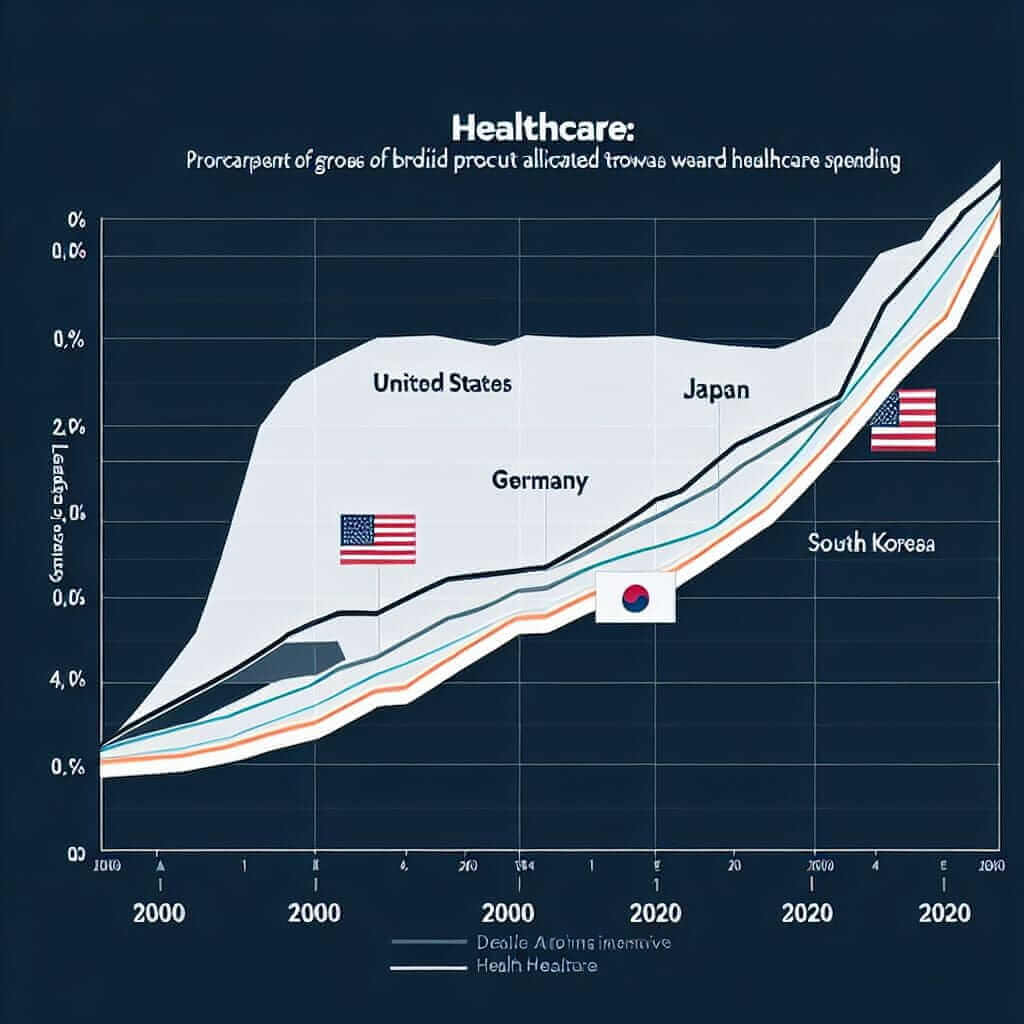The IELTS Writing Task 1 often presents data in various forms, requiring test-takers to showcase their analytical and reporting skills. The topic of “Public Health Expenditure by Country” is a recurring theme, reflecting global concerns about healthcare access and affordability. This article aims to equip you with the tools to effectively tackle such tasks and achieve a Band 7+ score.
Nội dung bài viết
- Understanding the Task: Public Health Expenditure in IELTS Writing
- Sample IELTS Writing Task 1 Question:
- Data Analysis and Report Writing:
- 1. Analyzing the Data:
- 2. Writing the Report:
- Introduction:
- Overview:
- Specific Details:
- Conclusion:
- Essential Tips and Vocabulary:
- Key Vocabulary:
- Achieving a Band 7+ Score:
Understanding the Task: Public Health Expenditure in IELTS Writing
Before delving into data analysis, it’s crucial to comprehend why “Public Health Expenditure by Country (2000-2023)” is a frequently appearing theme in IELTS. This topic intersects with:
- Global Relevance: Healthcare expenditure is a pressing issue worldwide, making it a relevant topic for the diverse IELTS test-taker population.
- Data Interpretation: The topic lends itself well to visual representations like graphs, charts, and tables, which are core components of Task 1.
- Vocabulary Enhancement: It allows you to demonstrate your grasp of economic and healthcare-related vocabulary, a key factor in achieving a high band score.
Sample IELTS Writing Task 1 Question:
You should spend about 20 minutes on this task.
The table below shows the percentage of GDP spent on healthcare in four different countries from 2000 to 2020.
Write a report for a university lecturer describing the information shown below.
| Country | 2000 | 2005 | 2010 | 2015 | 2020 |
|---|---|---|---|---|---|
| USA | 12.5 | 14.2 | 16.1 | 17.0 | 18.7 |
| Germany | 9.8 | 10.2 | 11.1 | 11.5 | 12.8 |
| Japan | 7.6 | 8.5 | 9.2 | 10.1 | 10.9 |
| South Korea | 5.2 | 6.0 | 7.1 | 7.8 | 8.9 |
Write at least 150 words.

Data Analysis and Report Writing:
1. Analyzing the Data:
- Overall Trend: There’s a general upward trend in healthcare expenditure as a percentage of GDP across all four countries from 2000 to 2020.
- Highest Spender: The USA consistently allocated the highest percentage of its GDP to healthcare throughout the period.
- Lowest Spender: South Korea consistently spent the least on healthcare, though its expenditure showed a steady increase.
- Notable Changes: Germany and Japan displayed more gradual increases compared to the steeper rise in the USA.
2. Writing the Report:
Introduction:
The table illustrates the proportion of Gross Domestic Product (GDP) allocated to healthcare in four nations – the USA, Germany, Japan, and South Korea – over two decades, from 2000 to 2020.
Overview:
Overall, healthcare expenditure as a percentage of GDP rose in all four countries during the period under review, with the USA consistently dedicating the largest share. Conversely, South Korea, while exhibiting an upward trajectory, remained the lowest spender.
Specific Details:
In 2000, the USA allocated 12.5% of its GDP to healthcare, a figure that surged to 18.7% by 2020. Germany, starting at 9.8%, saw a more moderate increase to 12.8% over the same timeframe. Japan’s expenditure grew from 7.6% to 10.9%, while South Korea, starting from the lowest point of 5.2%, reached 8.9% by 2020.
Conclusion:
The data highlights the growing economic significance of healthcare across these nations, with the USA demonstrating the most pronounced growth in healthcare spending as a share of its GDP.
(Word count: 169 words)
Essential Tips and Vocabulary:
- Paraphrasing: Avoid directly copying words from the question. Use synonyms like “illustrates” instead of “shows,” “proportion” for “percentage,” etc.
- Data Comparison Language: Utilize comparative and superlative adjectives (“higher,” “steepest,” “most significant”) and adverbs (“steadily,” “gradually”).
- Trend Vocabulary: Familiarize yourself with terms like “upward trend,” “downward trend,” “fluctuate,” “peak,” “plateau.”
- Conciseness: Be direct and avoid redundancy. Every word should contribute to conveying the information or your analysis.
Key Vocabulary:
- Gross Domestic Product (GDP): (Noun) /ɡroʊs dəˈmɛstɪk ˈprɒdʌkt/ The total value of goods and services produced in a country during a specific period.
- Allocation: (Noun) /ˌæləˈkeɪʃən/ The distribution of resources for a particular purpose.
- Surge: (Verb) /sɜːrdʒ/ To increase suddenly and powerfully.
- Moderate: (Adjective) /ˈmɒdərət/ Average in amount, intensity, quality, or degree.
- Trajectory: (Noun) /trəˈdʒɛktəri/ The path followed by a projectile or object moving under the action of given forces. (In this context, refers to the trend of expenditure)
Achieving a Band 7+ Score:
To excel in IELTS Writing Task 1, focus on:
- Accurate Data Representation: Avoid misinterpreting or misrepresenting the data provided.
- Coherence and Cohesion: Ensure a logical flow of information using linking words and clear paragraphing.
- Grammatical Range and Accuracy: Employ a variety of sentence structures and grammatical constructions accurately.
- Lexical Resource: Use a wide range of vocabulary related to trends, data, and the given topic.
By understanding the nuances of data interpretation, mastering relevant vocabulary, and practicing regularly, you can confidently approach the IELTS Writing Task 1 and achieve your desired band score.